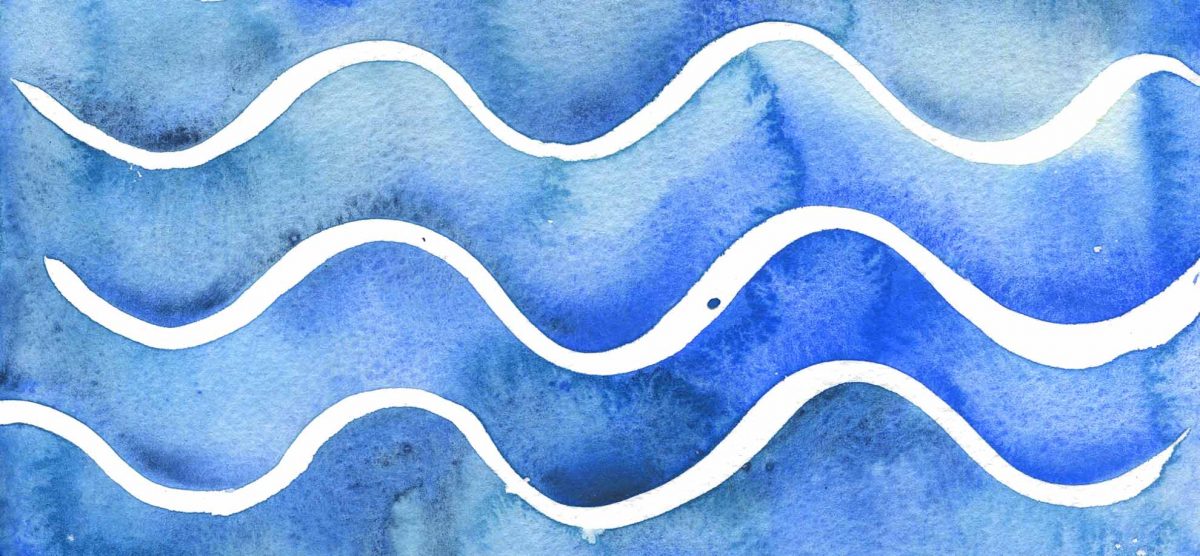If you’re anything like me, you’ll love wandering around art shops looking at watercolour supplies. In fact, I think buying supplies is an entirely separate pastime to actually painting with them!
As you’re standing in front of the watercolour section, it’s easy to spot a glass bottle containing masking fluid and wonder what it is and how it works. Here’s the lowdown!
What is masking fluid?
Masking fluid is a liquid latex material. It’s used to mask off and protect areas of the paper from the watercolour paint, and it can be rubbed off when the painting is dry to reveal the pristine white paper underneath. Generally, masking fluid is cream or blue so it’s visible as you’re painting over it.
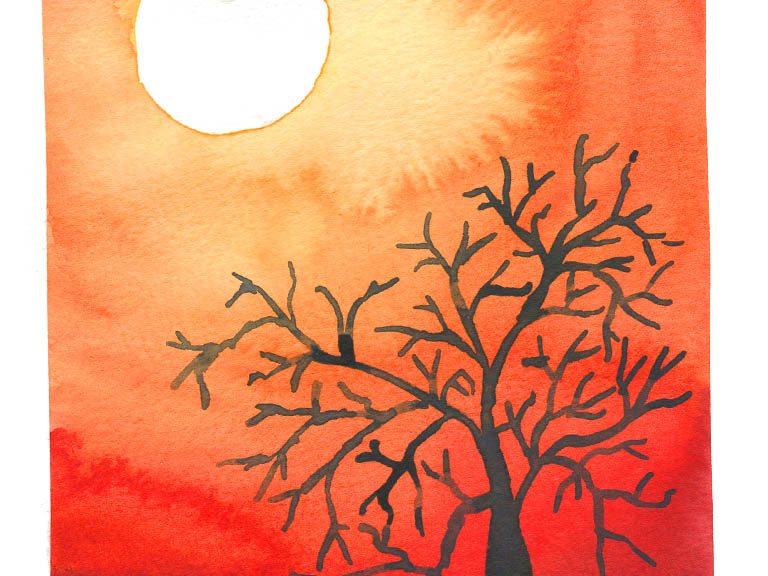
How does masking fluid work?
It’s a great way to keep highlights and white space in your watercolour painting. As you probably know, there’s no real white colour in watercolour – we normally leave parts of the paper clear of paint to provide whites and highlights, which is known as white space. Masking fluid means you don’t need to paint carefully around any spots, and it opens up a whole world of creative possibilities.
For example, you could protect a circle of white for the sun or moon in a sky painting. It makes it easier to paint smooth washes or gradients without having to worry about avoiding the area.
How to use masking fluid
Use masking fluid to mark off any areas you don’t want to paint on. It helps to plan this out before you start painting – you can also sketch out your piece if it helps. Apply your masking fluid over those areas in an even layer, making sure you don’t miss any spots. It works best if you apply it over small areas – very large areas can be harder to remove.
It’s important that you let the masking fluid dry before adding paint to the paper, and then let the paint dry before removing the masking fluid.
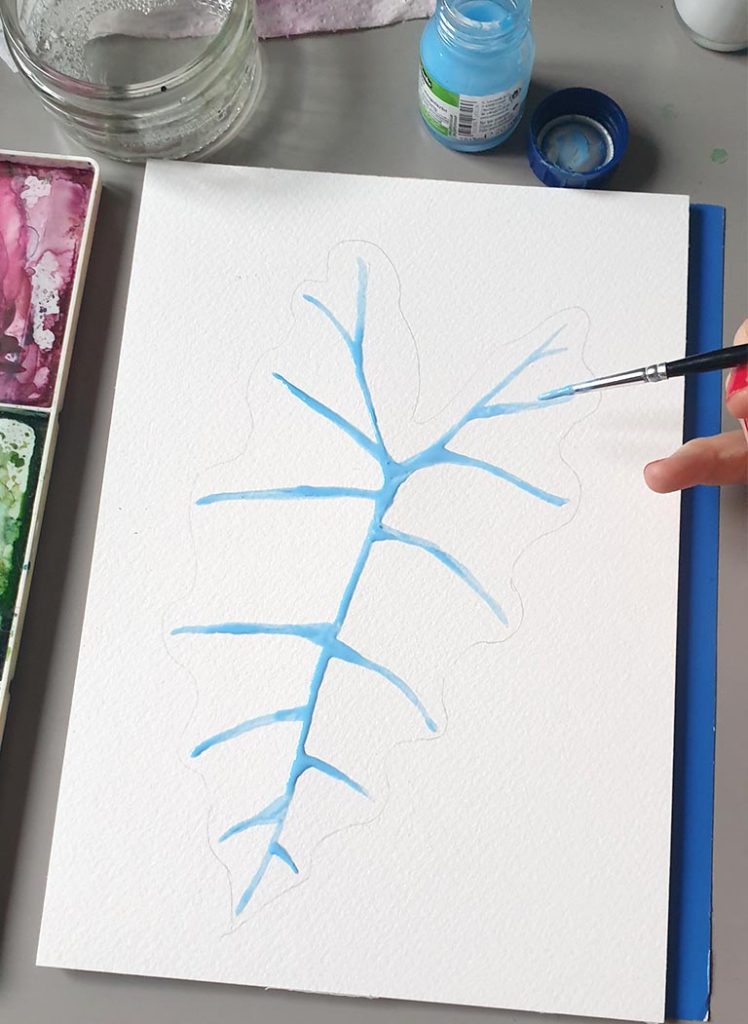
How to apply masking fluid
When you open the bottle and spot the thick latex, this is going to be your first question! Some masking fluids come with an applicator such as a thin needle for getting fine lines. But for most brands, you’ll need to apply masking fluid with a paintbrush, a silicone brush or another applicator from around your home.
If you want to use a paintbrush, it’s important not to let the masking fluid dry on the brush. The latex will set into the bristles and render the brush useless for regular painting – it’ll be clumpy and stiff. And if the latex does dry, it will be impossible to get out. I ruined a few expensive watercolour brushes before I realised this!
You can either use an old brush you don’t mind losing, or create a barrier by using washing up liquid (dish soap for US readers). Mix up a separate pot of water and add a good amount of soap, then swirl your brush in there to coat it with a protective layer. Dip into the masking fluid and apply to your paper as normal, before washing the brush off really well before it starts to dry.
You can also buy special silicone brushes, sometimes called masking fluid brushes. These have a chunk of silicone on the end which can be dipped into the masking fluid and applied to the paper. If the latex starts to dry, it will simply peel off the silicone. I find these tricky to use for a smooth layer of masking fluid but others rave about them.
Finally, you can look for more creative ways to apply it. How about using a cotton bud, or a dip pen? And a toothbrush dipped in masking fluid and splattered on the paper will create great tiny stars in galaxy paintings. Or you can drip it on the surface, or use a pipette – the options are endless!
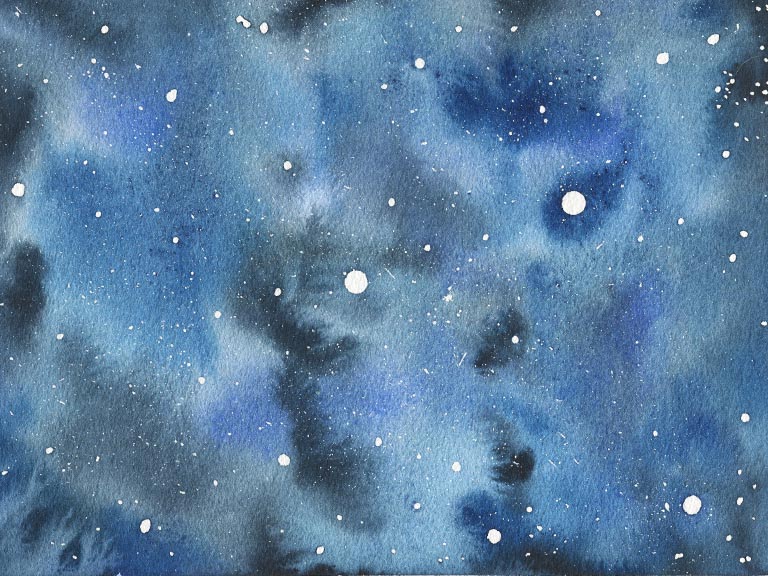
Painting over masking fluid
Once your masking fluid has fully dried to the touch, you can begin your painting. It’s safe to paint over the masking fluid to create smooth blends and gradients. But try not to rub it with your brush, or you may disturb the latex and leak the paint through.
You may find that your paint beads up over the masking fluid – this is normal. However, it can help to pick it up with a paper towel so you don’t smudge the paint as you remove the latex.
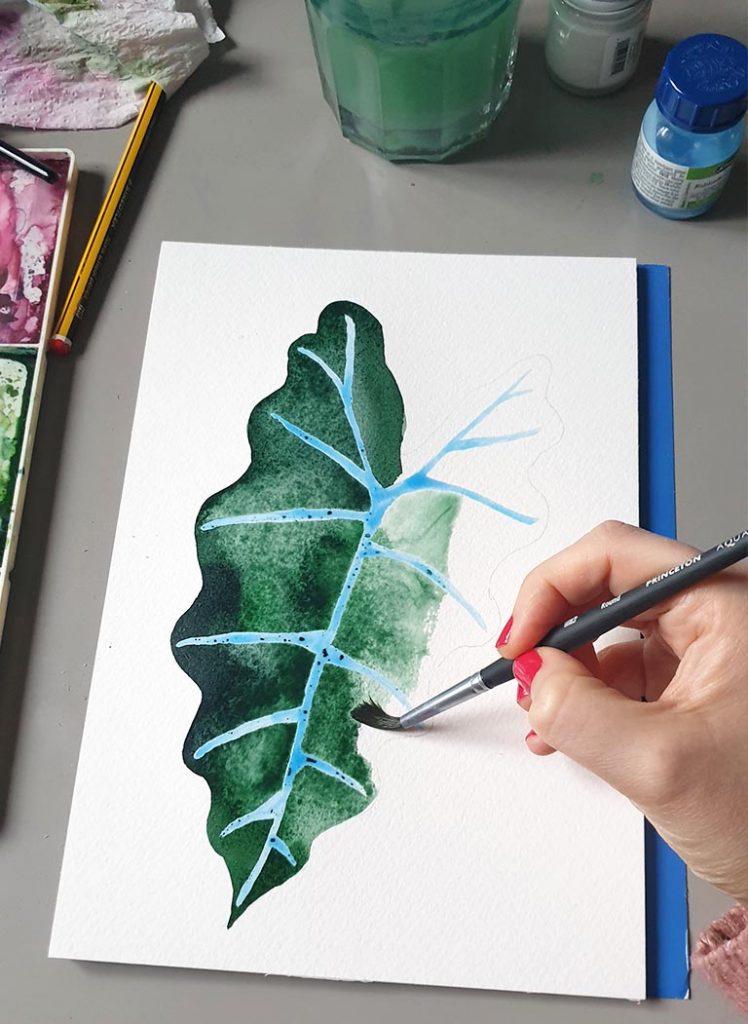
How to remove masking fluid
First things first – make sure your watercolour is completely dry! If not, everything with smudge together.
The easiest way to remove masking fluid is with your finger. Make sure it’s clean so you don’t smudge paint into the white space. Gently rub your fingertip back and forth over one edge – it should start to lift up into little balls. Some masking fluids are stretchy enough that you can peel them up, while others disintegrate into crumbs as you rub it.
You can also use a clean cloth, small towel or the corner of a rubber eraser to rub it off without smudging. Make sure it’s clean and dry, and watch out for it picking up any watercolour paint as you go. Be gentle and patient and try not to scrub.
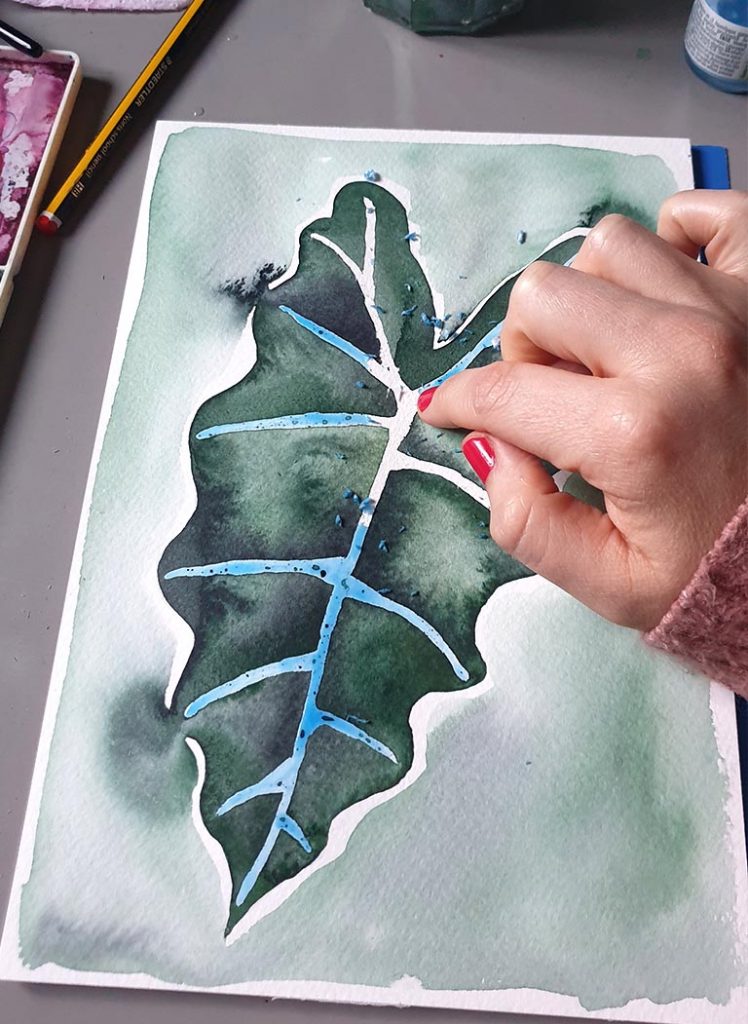
Help! My masking fluid won’t come off!
Many beginners with watercolour report problems removing masking fluid. Make sure your paper is bone dry before applying masking fluid. Then make sure it’s also fully dry after painting, before you start removing it. And don’t leave the masking fluid on too long – after it few days it bonds completely!
If it’s being stubborn, try using a cloth over your fingertip and a bit more pressure. You can also use a small knife or something sharp under one edge. However, if it’s tearing the paper as it lifts then you may not be able to save it! The best thing to do is test the masking fluid on a scrap of paper first to make sure it works as you want.
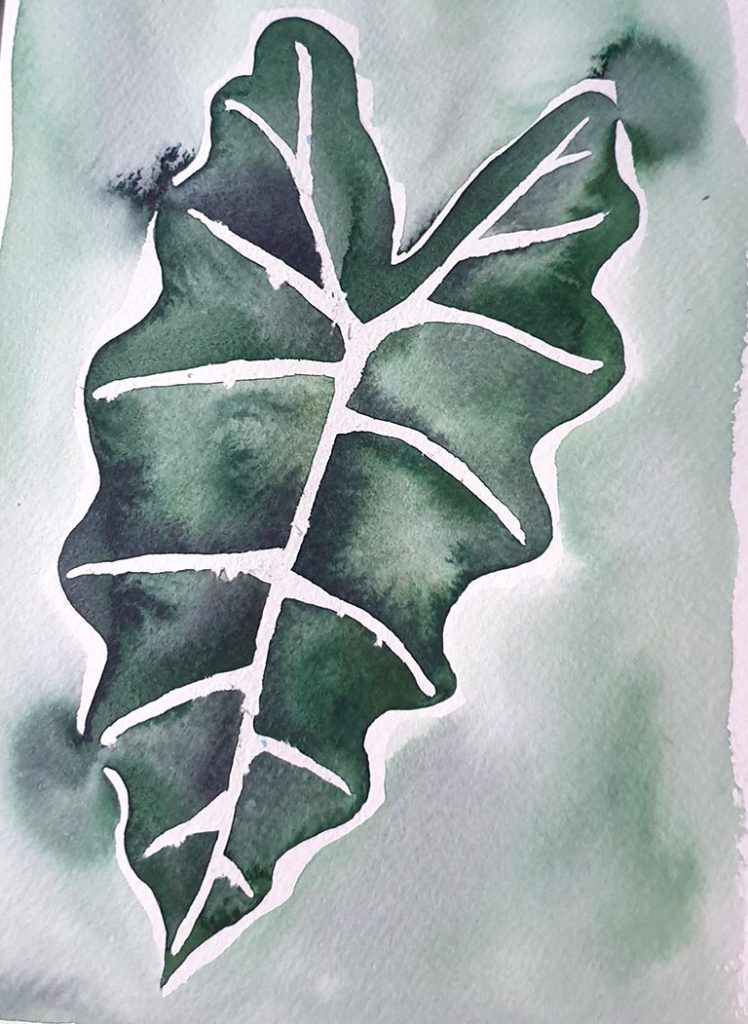
Using masking fluid over dry paint
You can also use masking fluid over dried paint to help maintain the colour while you paint more layers. Simply follow the process as above, but make sure your paper is bone dry before adding the masking fluid. Then make sure your masking fluid is fully dry before adding more paint. It won’t work if any layers are still even slightly damp so err on the side of caution to make sure the masking fluid peels off properly.
Best masking fluid for watercolour
There are lots of different formulations based on your preferences. Here are the two I use and love:
Schmincke masking fluid
A lovely light mixture that shows up blue, which is ideal if you like to be able to see your masked areas as you paint. It goes on smooth and peels up well without damaging the paper.
Winsor & Newton masking fluid
A creamy latex version, it smells a little but peels up in a smooth elastic way. It’s more cream-white toned than the blue one above and a little thicker, but still a good quality product.
That’s everything you need to know about masking fluid! Happy painting!
Download my free watercolour supply guide
Feeling overwhelmed and confused by watercolour paints, papers and brushes? Download my free guide filled with insider info, including a list of good supplies for every budget, and my complete supply list!
